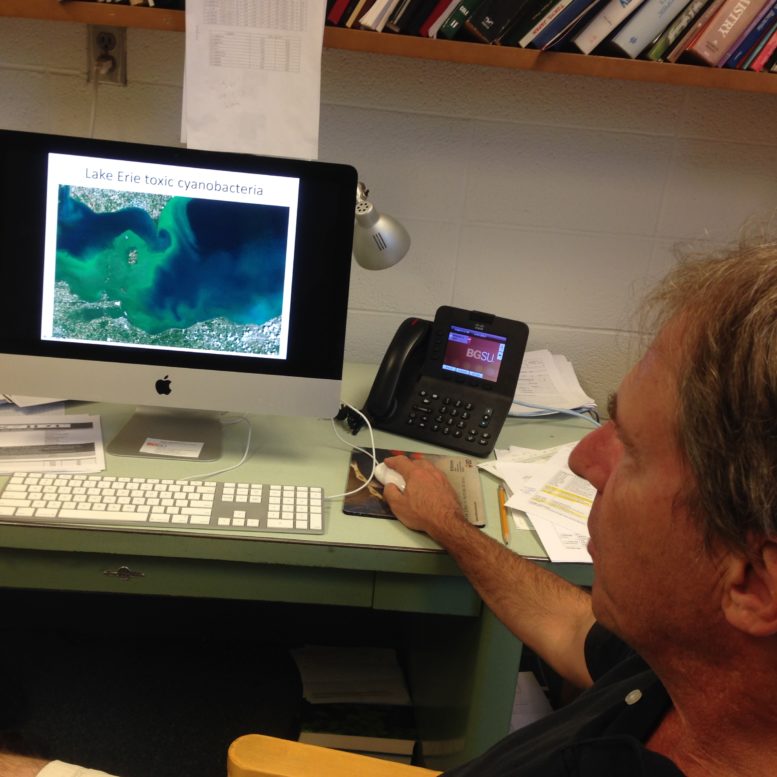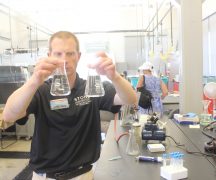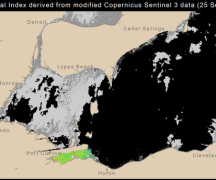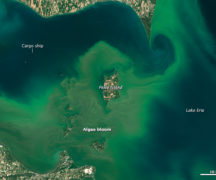From BGSU OFFICE OF MARKETING & COMMUNICATIONS
Ohio’s Environmental Protection Agency and Gov. John Kasich have designated the western basin of Lake Erie – from Toledo to Marblehead – as an impaired waterway due to toxic algae. This designation comes after consultation with experts from Bowling Green State University, among other organizations.
“This is a great first step, a recognition of the fact that these blooms are impairing Lake Erie,” said Dr. Timothy Davis, BGSU associate professor of biological sciences. “This is clearly the right decision.”
Davis and Drs. George Bullerjahn, Professor of Research Excellence, and Michael McKay, Ryan Endowed Professor, all in the Department of Biological Sciences were part of the team that developed the criteria used to declare the open waters of the western basin of Lake Erie impaired. This included determining what metrics should be used and how they should be used.
“We’ve known for a while that these blooms have been a major issue to the region, and this is really a formal acknowledgement of that issue,” Davis said. “It gives us a benchmark to work toward to delist it.”
“It’s going to take significant nutrient reduction from the watershed to remove the impairment designation,” Davis said. “In conjunction with Annex 4, which recommends a 40 percent phosphorus reduction, we will now have great targets to aim for to reduce the impact harmful algal blooms are having in the western basin of Lake Erie.”
The team advising the Ohio EPA also included scientists from the National Oceanic and Atmospheric Administration, Ohio State University’s Sea Grant College Program, the University of Toledo and the U.S. EPA in making this determination.
Lake Erie — its water, inhabitants and surrounding habitat — has long been the topic of research by BGSU biology faculty. Bullerjahn, Davis and McKay all have a deep history of expertise in and support of Lake Erie water quality research and support.
Davis has worked with the EPA previously; he was appointed to the agency’s Board of Scientific Counselors (BOSC), a federal advisory committee that provides advice, information and recommendations to the EPA’s Office of Research and Development on its research programs. As part of this three-year term, Davis serves as a member of the BOSC Safe and Sustainable Water Resources (SSWR) subcommittee.
He has spent the last 11 years studying the ecology of harmful algal blooms (HABs). During the course of his research, Davis looked at understanding the environmental drivers of HABs in several lakes throughout the Northeast, including Lake Erie and Lake Champlain.
Internationally known experts in harmful algal blooms and other aspects of water quality, Bullerjahn and McKay are involved in multiple projects centered on the lake. Their research into dead zones in Lake Erie’s central basin, with Dr. Paul Morris, has been supported by the U.S. Department of Energy’s Joint Genome Institute. The information they have gained from that study complements their Ohio Sea Grant and National Science Foundation-funded studies of nitrogen cycling in the Great Lakes. They have taken a particular interest in the winter environment of the lake, work that has been supported by the National Science Foundation, with additional in-kind contributions from the U.S. Coast Guard and Environment Canada.
Bullerjahn, Davis and McKay formed a rapid response team when in September 2017 the Maumee River experienced a highly unusual algae bloom, turning the river a deep green and alarming residents and municipal water officials. They swiftly created a plan to identify and quantify the cyanotoxins — toxins produced by cyanobacteria — as well as genetically quantify the potentially toxic cyanobacteria in this bloom to assess its risk to the regional water treatment plants and industries. Working with a team of collaborators from the University of Toledo, the State University of New York College of Environmental Science and Forestry, the Ohio Environmental Protection Agency (EPA) and Defiance College, they drafted a Rapid Response Proposal and received funding from the National Centers for Coastal Ocean Science, a division of the National Oceanic and Atmospheric Administration, to collect samples and conduct the analyses.
Along with their Lake Erie research, Bullerjahn and McKay recently completed a $250,000 research project titled “Harmful Algal Bloom Detection, Mapping and Warning Network: Sandusky Bay,” aimed at protecting the Sandusky city water supply. Partnering on the effort were Kent State University and The Ohio State University’s Stone Lab. The project was part of an overall $2 million Lake Erie water quality initiative by the Ohio Department of Higher Education. They, along with Davis, were recently awarded over $300,000 in additional support from the third round of the state’s Harmful Algal Bloom Research Initiative.
The goals are to identify emerging toxins and to provide early warning of toxic cyanobacteria outbreaks to area water plant managers so they can respond quickly and appropriately to the intensity and extent of the toxic bloom.
The longer-term goal is to better understand these blooms by monitoring water conditions and measuring and mapping toxin levels. These data will be used to develop models that can predict the conditions under which blooms become toxic and pose a health concern.
Even longer-term is solving the basic biological question of why these near-shore environments foster the microorganisms that produce the toxins.
In 2015, Bullerjahn and McKay hosted a workshop called “Global Solutions to Regional Problems” featuring the top experts from around the world discussing how to deal with the growth of harmful algal blooms. In collaboration with the National Oceanic and Atmospheric Association and sponsored by the National Science Foundation, the event highlighted BGSU as a leading contributor to global solutions.
During the 2014 Lake Erie water crisis, Bullerjahn gave a highly informed and human voice to the problem, educating media members, legislators and fellow scientists from around the world on harmful algal bloom dynamics and their effects on the regional ecosystem in general; and on northwest Ohio’s water supply in particular.





